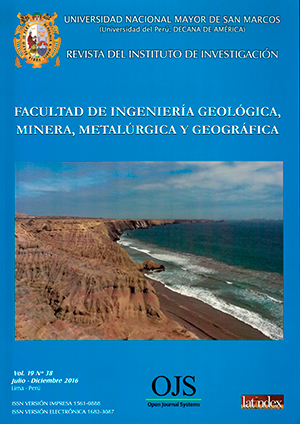Ultrasonic waves applicated in biodisel produced with differents vegetables oils
DOI:
https://doi.org/10.15381/iigeo.v19i38.13581Keywords:
Polluting Waste, ultrasound, biodiesel, transesterification, acid value, recyclable canola oil, linseed oilAbstract
Refined vegetable oils are nowadays used not only in food but also as a raw material in the production of biodiesel, this use has generated some controversy by different factors among which also have social environmental. On the other hand, large amounts of vegetable oils are discarded after use in food and fried foods such as pollutants considered waste which can be better utilized for the production of biodiesel but has disadvantages in lower costs and yields . Therefore, was made a comparative study for the production of Biodiesel from refined vegetable oil (canola), unrefined (linseed) and recycling (canola) with ultrasound equipment. The parameters evaluated for the production of Biodiesel were yield, acid value, and refractive index. Ultrasound is a methodology considered clean for environmental sustainability. In this work, this method was compared with the traditional method for the production of Biodiesel. For transesterification were worked with the traditional method and with the ultrasound method (frequency 20 kHz) in two stages: 15 minutes and 30 minutes, the molar ratio of the reactants 1: 6 (1 mol of fatty acid: 6 mol methanol), the catalyst was KOH 1.5% w / w the process temperature was considered in the range of 65-78.5 ° C. The maximum yield for the production of Biodiesel from: Canola oil was they reached with the traditional method (83.37%, 0.22 acid value ; higher compared to the ultrasound method), recyclable oil and linseed oil were achieved with the ultrasound method (82.6% and 89.3%, with a reduction in the acid value in accordance with international quality standards Biodiesel). The use of ultrasound method reduced the processing time for obtaining biodiesel (30 min) as well as high yields (89.3%)Downloads
Published
Issue
Section
License
Copyright (c) 2016 María E. Fuentes-Campos, Marleny D. Aranda S., Susana T. Gómez G.

This work is licensed under a Creative Commons Attribution-NonCommercial-ShareAlike 4.0 International License.
AUTHORS RETAIN THEIR RIGHTS:
a. Authors retain their trade mark rights and patent, and also on any process or procedure described in the article.
b. Authors retain their right to share, copy, distribute, perform and publicly communicate their article (eg, to place their article in an institutional repository or publish it in a book), with an acknowledgment of its initial publication in the Rev. Inst. investig. Fac. minas metal cienc. geogr.
c. Authors retain theirs right to make a subsequent publication of their work, to use the article or any part thereof (eg a compilation of his papers, lecture notes, thesis, or a book), always indicating the source of publication (the originator of the work, journal, volume, number and date).























